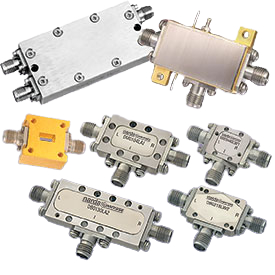Translate:
Image Rejection Mixers

The output or IF frequency of a downconverting mixer is equal to the difference between the LO (local oscilator) and the input RF frequency. Consequently, two different input RF frequencies above and below the LO (like mirror images) will yield the same output or IF frequency. The receiver designer commonly chooses the LO to be above or below the desired RF input upon spur products, interference, spectrum inversion, etc., but in any case, the other unwanted RF response is defined as the image. Mathematically, image frequency equals 2LO-RF.
Full Image Rejection Mixers Catalog Listing
Ideally, the low-noise RF amplifier preceding the mixer should only amplify weak RF signals and any noise in that same signal bandwidth. However, the amplifier will also amplify other input noise surrounding the signal bandwidth, including the image frequency. If the mixer following the RF amplifier is broadband, (ie, has two responses, real and image), then the additional undesired amplifier image noise will add to the desired real response at the mixer output. Thus, with twice as much output noise for the same desired signal level, our system noise figure is degraded by 3 dB. Even if the RF preamplifier had high enough gain to mask the noise contribution of other components in the receiver chain, the useful noise figure is still 3 dB higher than the measured noise of the preamplifier alone.
In any mixer two different input RF frequencies (above and below the LO by the same offset or IF frequency) will yield an identical output frequency. The most significant difference is that if one changes the phase of the incoming RF that is above the LO frequency by -90??, the IF output from that signal will also change by +90??. The same +90?? change in the image (RF below LO) will yield a -90?? IF change (in the parlance of mixer technology they are conjugates of each other). Image rejection mixers exploit this fundamental fact by first dividing the incoming RF signals into two equal paths with 90?? phase differences. The hybrids used for this purpose are wide bandwidth, thus affecting real and image frequency. Furthermore, if the two RF hybrid outputs are used to feed two identical mixers driven from the same in-phase LO, their IF outputs will also differ by 90??. However, as we might suspect, the mixer IF outputs lead and lag each other by 90?? for the image and RF inputs, respectively. Separating the IF outputs for image and real RF is then an easy task with an IF 90?? hybrid.
Image Rejection Mixers:
Passive Image Rejection Mixers
Active Image Rejection Mixers
Low Noise Image Rejection Mixers
Single Balanced Image Rejection Mixers
Double Balanced Image Rejection Mixers
Subharmonic Image Rejection Mixers
Narda-MITEQ can also offer customized solutions that meet your specific requirements
Please contact Component Sales with any special requirements you may have: Tel: 631-231-9220
Narda-MITEQ Mixers are backed by Narda-MITEQ's Warranty and most are available as RoHs Compliant components.
Mixers
Please Contact Narda-MITEQ for more information:
| Narda-MITEQ Sales Team Email: componentsnm@nardamiteq.com Phone: +1 (631) 439-9220 |
More Contact Options...


